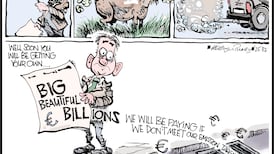Poor households are vulnerable to rising costs as they spend more of their income on housing, food and fuel, writes Paul Tansey
THE EUROPEAN Central Bank (ECB), now the final arbiter of all monetary matters in Ireland, raised its key interest rate from 4 per cent to 4.25 per cent on Thursday. As this increase in the cost of money is passed on to Irish borrowers later this month, it will add fuel to the fire of Irish inflation.
The rise in residential mortgage rates triggered by the ECB increase will, by itself, add 0.6 of a percentage point to the annual rate of consumer price inflation, according to Central Statistics Office (CSO) calculations.
Already, Irish households are feeling the pinch of higher prices. The cost of living for the average Irish household increased by 4.7 per cent in the year to May, according to the latest Consumer Price Index released by the CSO. In the first five months of the year, the annual inflation rate has averaged 4.6 per cent, confounding those forecasters who anticipated a swift decline in the pace of price increase as the year progressed.
Two factors help to explain why inflation has remained stubbornly high, even in the face of a pronounced slowdown in the domestic economy. First, prices have been driven upwards by the surge in global commodity prices, particularly for energy and food. Second, Irish shoppers are not reaping the full benefits of a rising exchange rate.
Over the past year, the euro has strengthened in value by 18.5 per cent against sterling and by 18 per cent against the dollar. This should cut the price of imports from these two countries by almost one-fifth at a stroke. In turn, even allowing for the high operating costs of businesses in Ireland, the stronger euro exchange rate should be reflected in price cuts for British and US goods in Ireland's shops and supermarkets.
Moreover, the volumes of the transactions are not trivial. In 2007, one-third of all Irish imports of goods - worth over €20 billion - originated in Britain. The US supplied the Irish market with a further €7 billion worth of goods last year, equivalent to 11 per cent of total Irish merchandise imports. In total, almost 44 per cent of Irish imports of goods in 2007 were shipped from Britain and the US.
Alas, the payback from a strong exchange rate against the currencies of Ireland's major suppliers is not crystallising in a moderation of domestic inflation. The potential gains to Irish consumers appear to have been lost in currency translation.
The current surge in inflation is inflicting more hardship on the poor than the rich in Irish society. Already financially overstretched, poorer households are finding it difficult to cope with the steep increases in the cost of living.
At the same time, the prices of basic necessities that loom large in the budgets of poorer households have been rising at a much faster pace than the average rate of inflation over the past year. These basic necessities include food, housing, fuel and light.
Income is the principal determinant of the level of household spending. The gross income of the top 20 per cent of Irish households is 11 times higher than the bottom 20 per cent, as shown in Table I. This data is derived from the Household Budget Survey 2004/2005, published in July 2007 by the CSO. Three factors assist in explaining the marked disparities in gross incomes between rich and poor households in Ireland.
First, the poorest one-fifth of households are small in size, consisting on average of just 1.35 persons. The top 20 per cent of households are large, with an average of 3.67 persons. Second, the members of rich households are economically active, with an average of 2.15 people at work. In contrast, poorer households are economically inactive, with a very high proportion of people who are either retired or are occupied on home duties.
Third, those at work in richer households simply earn more money. Weekly spending exceeds weekly disposable income in the bottom 20 per cent of Irish households (and by a significant margin). Any rise in the cost of living widens the already considerable gap separating spending from income. This is the first threat posed by inflation to poorer households: it is driving them deeper into debt.
The data for 2004/2005 also indicates that middle-income households, in the midst of the credit boom, were living beyond their means. However, their weekly spending included almost €20 a week in life assurance and voluntary pension plan contributions. The top 20 per cent of households were well insulated against inflation by hefty savings rates.
Thus the first reason why inflation hits the poor harder is simple: they do not have the cushion of large cash balances to meet significant increases in their cost of living.
The second reason centres on the purchasing patterns of households at differing income levels. Poorer households spend more on necessities. In absolute terms, richer households spend more on everything. Enjoying more discretionary income, however, they spend more on life's little treats. The spending patterns of poor, middle and rich households in 2004/2005 are shown in Table II.
The most pronounced difference between poor and rich households is the proportion of weekly spending allocated to food purchases. The bottom one-fifth earmark almost one-quarter of their total spend for food, while the top one-fifth assign just 15.2 per cent of their spending for food. When meals taken outside the home are excluded, the bottom one-fifth spend 21.3 per cent of their budgets on basic foodstuffs, while the top one-fifth spend just 10.1 per cent on food purchases.
These disparities are all the more striking since the average size of poorer households is just 1.35 persons, compared to 3.67 persons in the top 20 per cent of households. Food and beverage prices have risen by 7.8 per cent over the past year, well ahead of the 4.7 per cent increase in the average cost of living. As poorer households devote a higher proportion of their total spend to food, they have suffered more from the high rate of food inflation.
Similarly, poorer households spend 8.4 per cent of their budgets on fuel and light, compared to the 2.6 per cent allocated to such purchases by the richest one-fifth. The average price for electricity, gas and other fuels increased by 7.2 per cent in the year to May, according to the Consumer Price Index, with home heating oil registering a 47.4 per cent rise over the 12 months. Again, as poorer households spend more than their richer counterparts on fuel and light, they bear a bigger burden from the rapid rise in energy-related prices. Moreover, given the seemingly unending rise in oil prices, very substantial price rises for energy-related products are coming down the tracks for Irish consumers.
Poorer households also spend proportionately more on housing than richer households. Over the past year, housing costs have risen three times faster than the average inflation rate, rising by 14.1 per cent. Even before the latest ECB increase, mortgage costs had climbed by 16.9 per cent in the year to May, while rents rose by 7.6 per cent.
Thus, prices have risen particularly rapidly in three areas over the past year - housing costs, energy-related products and food. The weight of these increases has fallen disproportionately heavily on poorer households. For the poorest 20 per cent spend almost 46 per cent of their household budgets on these items, while in the richest 20 per cent of households, they account for just 29.5 per cent of total weekly spending.
The most worrying factor of all in current conditions is that the absolute number of poor households will increase in the year ahead as unemployment continues to climb. According to figures released yesterday by the CSO, the numbers on the Live Register claiming unemployment benefits or credits reached 220,811 in June, an increase of 54,448 or almost one-third on the total a year earlier.
Paul Tansey is Economics Editor of The Irish Times








